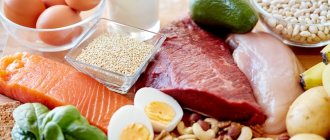- October 10, 2018
- Sports nutrition
- Sergey Severny
Beginning athletes often wonder how much 1 kg of protein will be enough, because it is not too cheap, and it makes no sense to buy supplements in smaller quantities. In this article we will tell you how many servings one can of protein is designed for, how and who should take it, and the pros and cons of using it.
What is protein?
Protein is a protein needed by the body to build muscles, tissue cells and bones. As a rule, a person receives the required amount of this substance from food, but athletes have a much higher need for protein due to increased physical activity. That is why almost all people who pay due attention to sports consume additional protein in the form of a dietary supplement.
Some people believe that taking sports nutrition has a very negative effect on health, but this is a big misconception. In fact, the protein supplement, usually sold in large 1-2 kg jars (how much this protein lasts is described in detail below), does not cause any harm to the body. It contains protein made from natural products. Which ones exactly depend on the type of additive.
conclusions
It's not when you drink it that matters, but how much you drink it. If the body does not have enough protein, it will “take” it from the protein you drink, either in the morning or at night, even before training, or even after.
I don’t recommend saving protein and drinking less than you need, hoping to “stretch out the pleasure.” You won't get any benefit from it. You also don’t need to drink more than you need. There will be no harm from this. You'll just be wasting your time translating part of the product.
Finally, I bring to your attention a review of the best proteins in the article TOP 10 best proteins in terms of price/quality ratio. Or you can use the selection below, where I chose the best ones from inexpensive ones (in my opinion):
- BioTech: Protein Power (78% protein)
- Syntrax Trophix (74% protein)
- Syntrax Whey Shake (77% protein)
What is protein?
Protein is a concentrated protein, “purified” of carbohydrates, fats and other additional substances. A person needs it to produce amino acids, which contribute to the growth of muscle tissue and its restoration. If people leading a passive lifestyle only need the protein they get from food, athletes who prefer strength training need additional “feeding.”
Protein, which comes in the following types, helps to cope with this problem:
- egg - made from eggs, is a “pure” protein concentrate, without other impurities;
- casein is a product of milk curdling;
- dairy - made from whey;
- meat - protein concentrate from natural meat (beef);
- soy - made from soy, suitable for vegetarians;
- whey - protein from whey;
- rice - vegetable protein, source - rice.
All these varieties of this sports supplement can be easily found in specialized stores, where they are usually sold in large jars of 1 kg. How much protein is enough in this volume and which one is better to choose, we will consider below.
Several bonus recipes
For those who are tired of the taste of standard cocktails, we will tell you how to drink protein correctly and tasty!
Recipe No. 1
- 40 g protein;
- 300 ml milk;
- 1 banana;
- 25 g walnuts;
- 2 tbsp. honey
Mix all ingredients and turn into a homogeneous mass with a blender. One such cocktail will replace a full meal.
Recipe No. 2
- 250 ml kefir;
- 40-50 g of protein;
- 4 tsp cocoa;
- 100 ml water;
- stevia (sweet substitute).
Dilute cocoa powder and stevia with water and cook until boiling. Cool the resulting liquid and add kefir with protein. Beat with a blender until smooth. It tastes better when drunk chilled.
How to choose a protein?
First of all, when choosing a protein, regardless of its origin, you should pay attention to the number of ingredients described in the composition. Ideally, it will contain less than 7-10 components.
When choosing a protein, try not to pay attention to manufacturers' advertisements. Often, in order to increase sales, a negligible amount of an additional ingredient is added to the dry mixture, which supposedly promotes rapid weight gain or weight loss. This is a common ploy for buyers. Perhaps consuming the substance in its pure form will indeed bring the desired effect, but in a jar with a kilogram of protein (how much is enough, described below) it is a grain of sand in the desert.
Next we come to choosing the form of the powder. All of them are conditionally divided into the following types:
- concentrate - a pure form of protein with an average rate of absorption, best taken between meals;
- isolate - has the property of rapid absorption, perfect for restoring strength and starting the process of muscle tissue growth after training;
- casein - a long period of absorption, as a rule, taken instead of dinner, a few hours before bedtime.
With this information, it is easy to decide on the choice of protein, taking into account individual needs. It is important to note that all of these supplements vary in price. The concentrate is much more expensive due to its “pure” composition, casein is the cheapest. Now it remains to understand how much 1 kg of protein will last, because it is usually sold in such volumes.
conclusions
It's not when you drink it that matters, but how much you drink it. If the body does not have enough protein, it will “take” it from the protein you drink, either in the morning or at night, even before training, or even after.
I don’t recommend saving protein and drinking less than you need, hoping to “stretch out the pleasure.” You won't get any benefit from it. You also don’t need to drink more than you need. There will be no harm from this. You'll just be wasting your time translating part of the product.
Finally, I bring to your attention a review of the best proteins in the article TOP 10 best proteins in terms of price/quality ratio. Or you can use the selection below, where I chose the best ones from inexpensive ones (in my opinion):
- BioTech: Protein Power (78% protein)
- Syntrax Trophix (74% protein)
- Syntrax Whey Shake (77% protein)
- Protein or gainer - which is better for gaining weight?
- 6 Misconceptions About Protein
- How to save money on protein purchases
- ALL about whey protein!
- Beef protein: advantages and features
COMMENTS
Protein intake rate
How much protein purchased at a sports store will last depends entirely on the volume of its consumption. To calculate your norm, you need to use the following formula - multiply your net body weight by 2-2.5.
The body's basic need for protein is 1 gram per day. This amount of protein is easy to get with food, which is why people who are not involved in sports have no need to consume protein in the form of a dry supplement.
But a person who spends a lot of time in the gym and focuses on strength training needs much more protein to saturate the body with the necessary substances. Since eating 6 chicken breasts or the whites of 8 eggs at one time is not an easy task, athletes completely replace one or two meals with sports nutrition. The powder is usually mixed with water, milk or juice.
Another important detail when calculating protein intake is its digestibility by the body. For some people, these processes occur faster, for others, on the contrary, very slowly. Thus, even with the correct calculations, each athlete takes protein with different efficiency. This is why some people grow muscles quickly, while others take years to grow.
Experiment in detail
Two groups of women stuck to a training plan—a strength training program, to be exact—for 8 weeks. The program consisted of two upper body and two lower body workouts per week. One group followed a high-protein diet, the second a low-protein diet.
Girls in the high-protein group received 2.45 grams of protein per 1 kg of body weight per day, including 25 grams of whey protein before and after each training session. The low-protein group received the following instructions: 1.2 grams of protein per 1 kg of body weight per day, including 5 grams of Dymatize ISO-100 whey protein before and immediately after training.
All participants received clear instructions regarding protein, but there were no restrictions regarding fats. By the end of the study, the girls who ate the high-protein diet had gained significantly more lean mass (2.1 kg) compared to those in the low-protein group (0.67 kg). Girls from the first group also managed to lose more fat, but the differences did not reach the threshold of statistical significance.
The study's results may not be earth-shattering, but they prove what you probably already knew. When women, especially those who train intensely, eat a high-protein diet, they build more muscle than women on a low-protein diet.
But here's what's surprising: Those in the high-protein group averaged 423 extra calories from protein every day! You would think that anyone who eats 400-500 extra calories every day for 8 weeks would end up gaining fat, but no, that didn't happen.
The girls in the high-protein group ended up losing more body fat than their competitors on the low-protein diet, even though they were consuming more calories! In numbers, the high-protein group, receiving more calories from protein, said goodbye to 1.08 kg of fat mass. Compare with 0.76 kg in the second group.
My study was the first in which only trained girls participated. However, comparable results were previously obtained in experiments in which only men or men and women participated. Scientists at Southeastern University have shown that 500-750 extra calories a day from protein - in their case it was - in combination with a strength training program does not lead to fat gain. However, unlike our study, the participants showed no noticeable changes in lean mass or percentage of body fat.
In light of our experiment, in which only girls participated, it can be assumed that women respond more acutely to an increase in daily protein intake by increasing lean body mass than men. However, all this is still just a theory, and more experiments are needed before we can say anything with certainty.
You've probably heard the phrase a hundred times: "Don't worry about what you see on the scale." Now you have every reason to take this advice! If we measured only weight in the experiment, it would turn out that the participants gained about 1 kg. There is no need to explain once again what a shock this could be.
But as good scientists, we assessed not only the mass, but also the compositional composition of the tissues. It turned out that the high-protein group built more muscle and burned more fat than the low-protein group—results you wouldn't get from just looking at the scale.
Instead of focusing on one number, monitor changes in your body fat and muscle percentage. If you notice that your weight has increased slightly and your fat percentage has decreased, you are on the right track!
I also recommend taking photos to document your progress, paying attention to how your clothes fit, and assessing your performance level in the gym. Positive changes in every aspect confirm that your diet and training program is really working!
How long is 1 kg of protein enough?
It is impossible to give an exact answer to this question, since everything depends on the weight of the athlete and his needs. The recommended dose is 2.1 grams per 1 kg of weight. Included with the jar, the buyer receives a measuring spoon that holds approximately 5-7 grams of protein.
Thus, if a bodybuilder’s body weight is 70 kg, he will need 10-12 tablespoons of dry powder to replenish the daily requirement. Based on these data, we can conclude how long a can of protein lasts for an active athlete. On average it is 14-20 days.
Amount of protein for muscle growth
People trying to gain weight should consume a certain amount of protein per day. Protein is the main building material of muscle tissue. If the amount of protein entering the body is insufficient, then the muscles will not only stop growing, but will also be destroyed. But if the daily protein intake is exceeded, disturbances in the functioning of the liver and kidneys may occur.
This is why it is so important to correctly calculate the amount of protein consumed. To gain muscle mass, you need to consume 1.5 to 2.2 g of protein per day per kilogram of body weight.
Advantages and disadvantages
The positive aspects of protein consumption are obvious. This substance accelerates the process of muscle growth and helps replenish the necessary elements in the body. Since the powder is made exclusively from natural ingredients, it does not pose any harm to health.
The only thing that novice athletes need to take into account is that protein is an additional source of protein, but not the main one. Under no circumstances should you replace all meals with a cocktail containing this supplement. Also, when calculating the daily intake of a substance, it is important to take into account and subtract the amount of protein that a person receives from food.
The disadvantages of the powder include its cost. It’s not without reason that people are so interested in how long 1 kg of protein will last. For protein concentrate you will have to pay an average of about 3 thousand rubles, 1000-1500 rubles. casein and soy protein will cost.
Protein absorption rate
Depending on the source of protein, the body absorbs 5-10 grams of amino acids per hour - this is the “throughput” of the walls of the small intestine. Does this mean that eating more at one time is pointless? No. The body adjusts to varying amounts of protein ingested, increasing digestion time if necessary until everything is absorbed.
So, in response to protein entering the stomach, the body produces the hormone cholecystokinin (). It slows down the contraction and emptying of the small intestine, giving amino acids more time to be absorbed (, ,).
In addition, the intestines themselves are able to absorb and retain large amounts of free amino acids, creating something like a temporary storage facility (,). It releases them into the bloodstream during large breaks in food or at night.
This also protects the body from a sharp increase in the level of amino acids in the blood, which it would have to oxidize with the formation of a large (and thus harmful, toxic) amount of urea, as a product of protein breakdown.
In a study of women, getting more than 54 grams of protein per meal was no different than eating the same amount divided into four meals (). Scientists have also found that rare, but high-protein meals are more effective for older women ().
Studies conducted during intermittent fasting have also shown that the body can handle much more protein than is commonly thought (, ).











